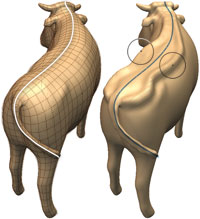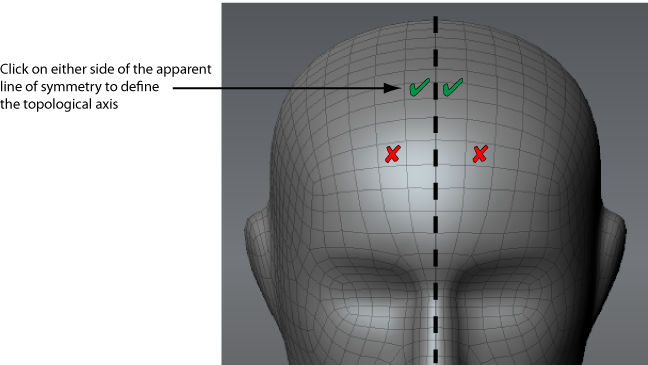The
symmetry tools let you reflect or mirror detail on one side of a
model to the opposite side.
Mudbox provides two symmetry
types:
- Tool symmetry -
Sculpted features appear across the axis of symmetry as you sculpt
in real time. You must turn on the Mirror property
in the tool Properties window. For more
information, see
Sculpt using tool symmetry.
- Layer
symmetry - Features are applied to a layer that can then
be mirrored across an axis of symmetry. For more information, see
Sculpt using layers.
Sculpt using tool symmetry
Tool
symmetry lets you sculpt on one side of a model and affect the vertices on
the opposite side of the model at the same time.
- Select a sculpt tool from the Sculpt tray.
The Properties window
displays the sculpt tool properties.
- In the Properties window,
turn on the Mirror property to the desired
symmetry setting. For example, X, Y, Z, Tangent,
and so on.
NoteWhen a model is topologically
symmetrical but posed in a way that is asymmetrical, you can still
sculpt/paint with symmetry by turning on the
Tangent mirror
property and defining the topological axis. This determines which
axis the tool mirrors across. See
Set a topological axis.
For more information
on the Mirror properties, see
Sculpt Tool properties.
Mirror sculpted detail
You can copy features
sculpted on one side of a model to the opposite side by mirroring
across an axis of symmetry using the Mirror option.
- In the Select/Move Tools tab,
select the Select Faces tool.
- In the 3D View,
select faces on the side of the model whose features you want to
copy.
- In the Layers window,
click the menu button (
 ), then
select the Mirror option for the axis
of symmetry you want sculpted features copied across (for example, X, Y,
or Z.)
), then
select the Mirror option for the axis
of symmetry you want sculpted features copied across (for example, X, Y,
or Z.)
NoteIf you have a symmetrical
model that is posed asymmetrically, you can use the
Tangent option
after setting a topological axis. See
Set a topological axis.
Swap sculpted detail between
opposite sides
You
can swap sculpted features between opposite sides of a model using
the Flip option. The sculpting
that appears on one half is exchanged with the sculpting on the
opposite half depending on the axis of symmetry you select.
- In the Layers window,
click the menu button (
 ), then
select the Flip option and the desired
axis of symmetry for the swap (X, Y,
or Z.)
), then
select the Flip option and the desired
axis of symmetry for the swap (X, Y,
or Z.)
NoteIf you have a symmetrical
model that is posed asymmetrically, you can use the
Tangent option
after setting a topological axis. See
Set a topological axis.
Set a topological axis
When a
model is topologically symmetrical but posed in an asymmetrical manner,
you can still sculpt/paint with symmetry by turning on the Tangent mirror
property and defining the topological axis. This determines the
axis the tool should mirror across (unless it has been previously
set).
NoteA model is topologically
symmetrical when it has an equal number of faces on each half and
the relationship of the border edges on the faces of the mesh on
one half match the opposite half.
- Ensure the model is topologically symmetrical.
- Press Page Down until you display the
base subdivision level (Level 0).
It is easier to select
faces when the mesh is displayed at the lowest subdivision level.
- Select two adjacent faces, one on each
side of the topological axis you want to define.
TipPress Shift + S to
select single faces regardless of tool size.
- Select Mesh > Set Topological
Axis.
You only need to define
the topological axis once. The information is stored with the model
and carried over to all subdivision levels.
NoteIf Mudbox cannot
determine topological symmetry based on your selection, an error
message appears on the status line. Ensure you are selecting faces at
the lowest subdivision level, then try again. If Mudbox continues
to indicate a lack of symmetry, the model is likely not topologically
symmetrical.
Notes on using tool symmetry
- Tool symmetry may not keep the tool strokes
100% symmetrical after extensive sculpting. This is true for all
live tool symmetry implementations for high resolution editing.
If preserving symmetry is critical in your project, use layer symmetry
instead.
- When using tool symmetry with stencils,
the primary tool and its reflection will likely scrub over different
parts of the stencil image, so the result of each stroke will be
asymmetric. If preserving symmetry is important to you while using
stencils, use layer symmetry.


